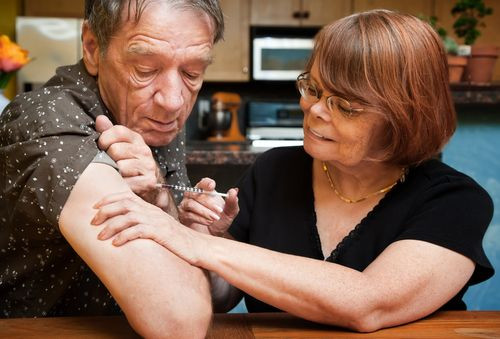Spousal Diabetes: Why Marrying A Diabetic Increases Disease Risk By 26%

Married couples living together share duties and responsibilities like paying the bills, doing the laundry, and dropping and picking up the kids from school. New research, however, shows they possibly share even more — the risk of a chronic disease. Spouses who are married to a diabetic are found to have a 26 percent risk of developing type 2 diabetes due to sharing poor eating habits and lazy lifestyles, according to a recent study published in the journal BMC Medicine.
Researchers from the McGill University Health Centre in Quebec, Canada, sought to determine whether this social clustering was indeed a risk factor for the non-diabetic spouse. The results from six studies that observed age, socio-economic status, and the way in which diabetes was diagnosed in over 75,000 couples, were obtained for systematic review and five for meta-analysis. The mean ages of these couples was between 52 to 74 years. The six observational studies, published between January 1997 to February 2013, included diverse populations from East Asian to naturalized Hispanics in the U.S.
The majority of the studies analyzed relied on health records which may not have always accurately recorded diabetes, the researchers wrote. Those that used direct blood testing suggested that diabetes risk doubles if your partner has diabetes, including a strong correlation with pre-diabetes risk found. Typically, when doctors are looking for diabetes risk in their patients, they often ask about family history, but now the team of researchers believes spousal history may be another factor to take into consideration.
The findings of the review revealed a 26 percent increase in the risk of developing type 2 diabetes if the spouse also has type 2. The study highlights the importance of carefully and specifically estimating shared diabetes risk within couples through the implementation of more effective screening strategies and better prevention and management that could be achieved by the collaborative effort between both partners.
“Our results suggest spousal history may be another factor we should take in consideration,” said Dr. Kaberi Dasgupta, researcher at the Research Institute of the MUHC and an associate professor of medicine at McGill University in the news release. “Moreover, it has been observed that men are less likely than women to undergo regular medical evaluation after childhood and that can result in delayed diabetes detection.” Dasgupta suggests spousal diabetes may be a potential tool for early diabetes detection.
Type 2 diabetes, formerly called adult-onset diabetes, is the most common form of the disease, which affects the way the patient’s body metabolizes glucose (sugar) — the body’s main source of energy. The National Diabetes Information Clearinghouse says approximately 95 percent of people with diabetes have type 2. Although the noninsulin-dependent disease is more prevalent in adults, it has shown to increasingly affect children due the rising rates in childhood obesity. Scientists believe type 2 develops when the body becomes resistant to insulin or when the pancreas stops producing enough insulin, but why this exactly happens remains unknown. However, excess weight and inactivity have been linked to being the principle culprits in a lot of type 2 cases. In regard to weight, the more fatty tissue a person has, the more resistant their cells become to insulin. Those that are overweight and are relatively inactive also increase their risk of type 2. Physical activity helps control a person’s weight, uses up glucose as energy, and makes their cells more sensitive to insulin, according to the Mayo Clinic.
Acknowledging the presence of a shared diabetes risk in couples could lead to a better adoption of healthy eating and physical activity patterns and behaviors in spouses. Although spouses are not genetically related, they share common living environments, social habits, eating patterns, physical activity levels, and other health behaviors that can impact diabetes risk. The authors conclude spousal history of diabetes/pre-diabetes has a twofold risk that is comparable to the twofold diabetes risk that is associated with diabetes history in one parent. Doctors may draw from these findings to adopt couple-based interventions that may help the diabetic spouse keep a balanced diet by making healthier food choices and increasing their physical activity levels.
Source: Dasgupta K, Leong A, and Rahme E. Spousal diabetes as a diabetes risk factor: A systematic review and meta-analysis. BMC Medicine. 2014.



























